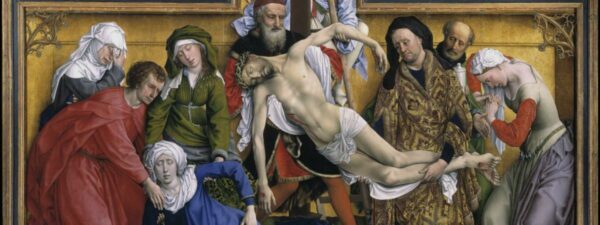Early Christian paintings were mostly about three themes, and the theme of death and resurrection was prevalent. In addition, Christianity’s canonical texts and scenes from the New Testament were also depicted many times, and a third theme was representations of Christ and the apostles.
Many Old Masters have been commissioned by their patrons to create Biblical paintings, and most of the artworks are still being appreciated by art lovers today.
This article will briefly look at five of the most famous Biblical paintings by Old Masters.
Christ in the Storm on the Sea of Galilee- Rembrandt Van Rijn

“The Storm on the Sea of Galilee” was created in 1633 as an oil-on-canvas painting by the Dutch painter Rembrandt van Rijn. Unfortunately, it was stolen in 1990 from the Isabella Stewart Gardner Museum in Boston. The painting has never been found again.
This painting forms part of Rembrandt’s many Christian paintings but is Rembrandt’s only seascape. The artist signed and dated the masterpiece. It is, however, unknown who commissioned the artwork.
Rembrandt depicted how the boat had been forced upwards by the waves to tilt the whole vessel. The storm’s violence is conveyed in various ways, but it is the expressions on the faces of the disciples that draw the attention first.
In contrast to the disciples struggling with the sails, others are seen lower down in the shadows and are relatively calm. In the lower part of the painting, the viewer’s attention is centered on Christ. It is as if Christ is the still point at the storm’s center.
The Last Supper- Leonardo da Vinci

Da Vinci’s “The Last Supper” is a well-known mural painting dated 1495–1498 and is one of the most famous religious paintings by Leonardo da Vinci. It can be described as a snapshot of the moment Christ tells his Apostles that one of them will betray Him. The painting depicts each apostle’s unusual reaction.
The mural painting was commissioned by Ludovico Sforza, the duke of Milan. He was Da Vinci’s patron during his stay in the city. Da Vinci included the Sforza coats of arms in the painting and also put the family’s initials on the three lunettes above the mural.
Leonardo began with the painting in 1495 and finished it in 1498. He experimented with new techniques. He used tempera or oil paint on two layers of dry preparatory ground. This meant that the pigments were not permanently attached to the wall, and the paint started to flake after a few years.
The mural underwent a 20-year-long restoration that was completed in 1999.
La Vierge au Lys” (“The Virgin of the Lilies”)- William-Adolphe Bouguereau

“The Virgin of the Lilies” is an oil painting by the French artist William-Adolphe Bouguereau. It was painted in 1899. A private owner now owns it. The painting is a majestic yet tender depiction of the Virgin Mary with her Son, Christ.
William-Adolphe Bouguereau’s painting “La Vierge au Lys” (The Virgin of the Lilies) exemplifies the then-emerging Art Nouveau style. His work was widely accepted and celebrated in his day, and Bouguereau was considered one of the most skilled painters by the French Salons. “La Vierge au Lys” demonstrates knowledge of balance and form and demonstrates an awareness of the trends of the then-contemporary art market.
Bouguereau’s paintings often dealt with Christian themes. As a result, his Biblical paintings were in great demand, and he received many commissions.
Creation of Adam- Michelangelo

“Creation of Adam” is one of the Italian artist Michelangelo’s most famous Biblical paintings. It is a fresco painting that forms part of the Sistine Chapel’s ceiling and was painted between 1508 and 1512. It depicts the Biblical creation as described in the Book of Genesis, where God gives life to Adam.
“The “Creation of Adam” depicts two figures: God on the right, and Adam on the left. God is portrayed as an elderly, yet muscular, male with gray hair and a long beard. This depiction of God differs from the “normal” depiction of the time. Rather than wearing royal garments, God is depicted wearing only a light tunic. Adam is depicted as lacking enthusiasm in his response to God. Adam’s body echoes the form of God’s body.
This painting shows several aspects of Michelangelo’s painting style, like the use of bodies that are both muscular and twisting. However, it has to be remembered that Michelangelo was a sculptor and not a painter in the first place. Thus, there are many “sculpture ideas” in this painting.
Doubting Thomas- Caravaggio

This work was painted in 1601/02 as a private commission while Caravaggio was in Rome. It was an unusual choice of subject in Rome at that time. Rome had no tradition of devotion to St Thomas. In this painting, Caravaggio shows Christ and only three apostles, and he zooms in to Christ and St Thomas. It depicts the scene where Thomas sticks his finger inside the wound.
Nobody before Caravaggio composed this Biblical theme with such a focus on the wound. All four figures in the picture stare intently at the finger as it penetrates the flesh of Christ’s side. If you look at the expressions on the three apostles’ faces, you see their amazement – either because Christ’s flesh is as accurate as theirs or Christ is letting this be done to him.
Of all Caravaggio’s artworks, this one has been copied the most. And although the exact circumstances of this commission are unknown, it is known that by 1606 this picture was in possession of Vincenzo Guistiniani. He was among Caravaggio’s most notable Roman patrons.
Conclusion
Over centuries the depiction of Biblical themes has always been popular. From about the 1400s until the late 1800s, many top artists in the Western art tradition have received commissions to create Christian paintings. As a result, there are famous religious paintings in almost all the Old Masters’ portfolios.



